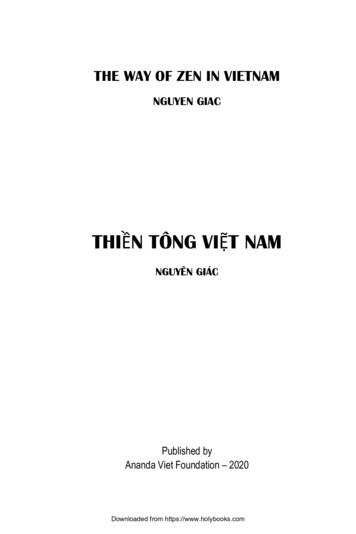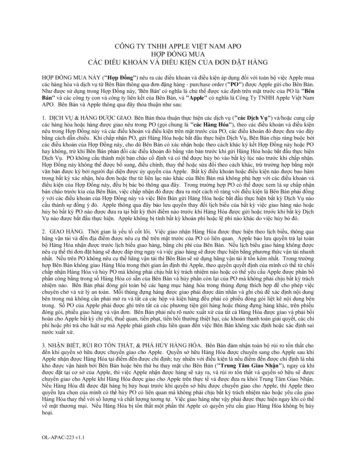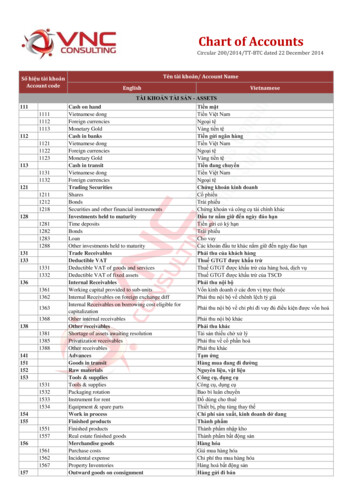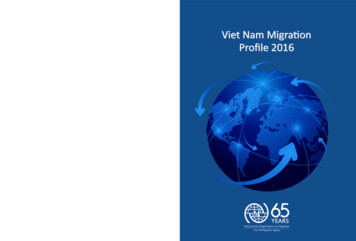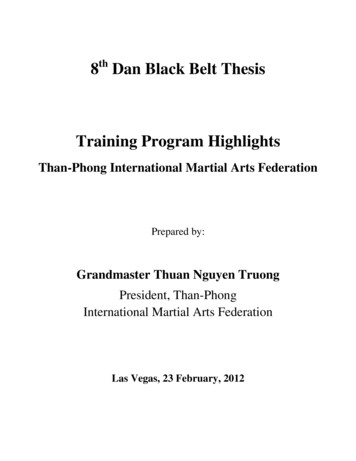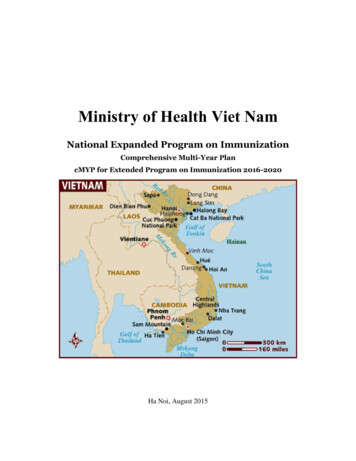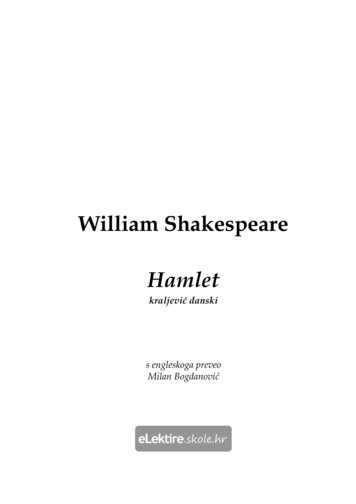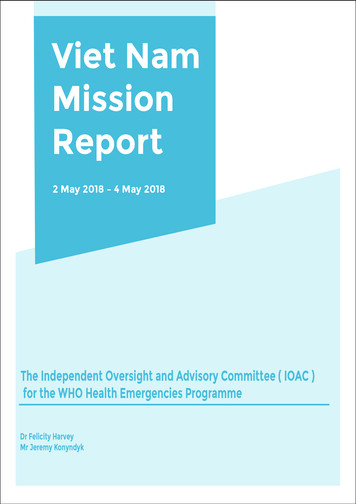
Transcription
Viet NamMissionReport2 May 2018 – 4 May 2018The Independent Oversight and Advisory Committee ( IOAC )for the WHO Health Emergencies ProgrammeDr Felicity HarveyMr Jeremy Konyndyk
ACKNOWLEDGEMENTSThe Independent Oversight and Advisory Committee for the WHO Health EmergenciesProgramme (IOAC) wishes to express its appreciation to the Government of the Socialist Republic of Viet Nam for the warm hospitality and collaboration. The IOAC is grateful to the WHO Country Office in Viet Nam, the Regional Office for the Western Pacific, and Headquarters for theexcellent support, which contributed to making the mission successful. Special thanks go to theGovernment officials, partners and WHO staff members who generously offered their time andshared their insights in a transparent manner.
MISSION OBJECTIVES ANDACTIVITIES CARRIED OUTField visits are a critical component of the IOAC’s1mission to assess the operationalaspects of theWHO Health Emergencies Programme (WHE)across the three levels of the Organization andits performance at country level.The IOAC chose Viet Nam for a field visit in orderto better understand the country’s successesand challenges with regard to health security.Specific aims were to study WHO’s role in thecountry’s approach to health security, to betterunderstand the key elements of Viet Nam’simpressive progress, and to extract lessons fromits experience with the Joint External Evaluations (JEEs) and National Action Plan. The visitprogramme was developed on the basis of theseobjectives.The IOAC met with the Health Minister and otherkey Government officials from the GeneralDepartment of Preventive Medicine, the Department of Planning and Finance, and the MedicalService Administration. The IOAC visited theNational Institute of Hygiene and Epidemiologyand the National Paediatric Hospital. In considering the country’s One Health approach, theIOAC also met with the Department of AnimalHealth, Ministry of Agriculture and AnimalHealth, in the presence of a representative fromthe FAO. To review progress on partnerships, theIOAC also interviewed the UN Resident Coordinator and representatives from the US CDC andUSAID in Viet Nam, and met with other partnersworking on health. The IOAC also hosted around-table discussion with the UN DisasterResponse Management Team and internationalNGOs.A set of selected documents and key referenceswas provided to the IOAC prior to the visit,including the Asia Pacific Strategy for Emerging194 000Total population (2016)Gross national incomeper capita (PPP international , 2013)39072/815Expenditure on healthper capita (Intl , 2014)Life expectancyat birth m/f(years, 2016)Source: http://www.who.int/countries/vnm/en/Diseases and Public Health Emergenciesadvancing implementation of the International HealthRegulations (2005), the Western Pacific RegionalFramework for Action for Disaster Risk Management for Health, and the mission report of theJoint External Evaluation of IHR Core Capacitiesfor Viet Nam. jeeta/WHO-WHE-CPI-2017.21-eng.pdf01
BACKGROUNDViet Nam is located on the eastern IndochinaPeninsula and is bordered by Cambodia, China,and the Lao People’s Democratic Republic. Themovement of people is increasing both withinthe country and beyond its borders, as itsfast-growing economy has propelled the countryinto lower-middle-income status. Viet Nam ishome to about 92.7 million people living in 63provinces.Viet Nam’s health system was originally built on astrong primary (“grassroots”) health care foundation, but this has been eroded due to the introduction of hospital-centric policies, which in turnled to increased health inequities. To tackle theseissues and achieve its universal health coverage(UHC) goals, the Government of Viet Nam recently adopted a new resolution on the protection,care and improvement of people’s health.2 It setsout the vision and objectives of national healthpolicy as well as major tasks and specific targetsto achieve by 2025 and 2030.Viet Nam has been a WHO Member State since 17May 1950, belonging to the Western PacificRegion. WHO established a Country Office inHanoi in 1977 and a suboffice in Ho Chi Minh Cityin 2003.The Western Pacific Region is prone to emerginginfectious diseases and natural disasters. VietNam was affected by severe acute respiratorysyndrome (SARS) in 2003, avian influenzaA(H5N1) since 2003, and the pandemic strain ofinfluenza A(H1N1) in 2009. The country faces newchallenges within as well as from outside theregion, including a complex burden of diseaseand the evolving impacts of development,change and globalization. Elsewhere, the recentoutbreaks of Middle East respiratory syndrome(MERS), Zika virus disease, influenza A(H7N9),and Ebola virus disease demonstrate that allcountries remain vulnerable to health securitythreats.To ensure public health security and to serve as aregional action framework, the Asia Pacific Strategy for Emerging Diseases (APSED) was developed in 2005. This strategy focused on buildingminimum capacities for dealing with outbreaksand public health emergencies, as required byIHR (2005). The APSED was updated in 2010 toexpand its scope from five focus areas to eightfocus areas. APSED was further upgraded in2016, becoming the Asia Pacific Strategy forEmerging Diseases and Public Health Emergencies (APSED III). APSED III is an overarchingstrategic framework for advancing IHR corecapacities for health security, agreed by MemberStates of the South-East Asia and Western PacificRegions. The framework provides an importantcollaborative platform for Member States, WHOand partners to work together to strengthenpreparedness and response to outbreaks andpublic health emergencies. APSED III focuses onenhancing the core public health functionsrequired to sustain and strengthen the entirehealth system, including linkage to other sectorsand health security initiatives to prevent,respond to and mitigate the impact of publichealth emergencies using an all-hazardsapproach.There is strong focus and leadership at theregional level, both from Member States and theWHO Regional Office.The Central Committee of the Communist Party of Viet Nam. Resolution of the sixth plenary session ofthe 12th Party Central Committee on the protection, care and improvement of people’s health in the newsituation (No. 20 -NQ/TW), 25 October 2017, Hanoi, Viet Nam202
SPECIFIC FINDINGS AND OBSERVATIONSViet Nam’s progress with healthsecurityViet Nam’s National Focal Point for IHR implementation was established in 2006 through adecision by the Ministry of Health.3 The standingbody of the IHR National Focal Point is housed inthe General Department of Preventive Medicineof the Ministry of Health.The first review of IHR (2005) implementation inViet Nam was conducted in 2012, and the country reported achieving minimum core capacitiesunder the IHR (2005) in 2014. Since the launch ofthe Global Health Security Agenda (GHSA) in2014, Viet Nam has been actively participatingand receiving funding accordingly, building onearlier support from donors and technical partners. The GHSA pursues a multilateral and multisectoral approach to strengthen both globaland national capacity to prevent, detect andrespond to human and animal infectious diseasethreats whether naturally occurring or accidentally or deliberately spread. 4Viet Nam undertook a JEE between 28 Octoberand 4 November 2016, and was the secondcountry in the Western Pacific Region to do so.The main objectives of the JEE were to evaluatethe country’s capacities in relation to 19 technical areas. The results, in turn, feed into a multiyear National Action Plan for health security.Both the Government officials and partnersinvolved in the JEE briefed the IOAC that therewas strong consensus on the usefulness of theJEE and its role as benchmarking tool. Theynoted that the JEE process was effective, andseen as helpful and useful by Government.Perceived benefits included taking awhole-of-Government view that has reinforceddialogue and linkages across different ministries, and enhanced interministry support forhealth security as a priority. The IOAC observed34Decision No. 4320/QDBYThttps://www.ghsagenda.org/03that the JEE served as a catalyst to connect GHSAand IHR core capacity requirements withcommon indicators to assess country capacities.The JEE mission concluded that substantialprogress has been made in Viet Nam towardsmeeting the IHR (2005) core capacity requirements and that the country possesses relevantexperience and capacity. Out of a total 48 JEEindicators, Viet Nam received a score of 4(demonstrated capacity) for 8 JEE indicators, ascore of 3 (developed capacity) for 26 JEE indicators and a score of 2 (limited capacity) for 14 JEEindicators.Viet Nam was advised to ensure compliance andconsistency with IHR requirements throughenhancing plans and procedures to supporthealth security, through improving multisectoraland multidisciplinary coordination at nationallevel, and through strategic investment in asustainable system for health security.During the visit, the IOAC noted the country’sfocus on strengthening primary health care.Further support and guidance from WHO isrequired with regard to coordination of thedifferent entities of the Government arounddisease reporting systems, data managementand the proper use of the Emergency OperationCentre. The IOAC noted that the EmergencyOperations Center appears to be activated onlyinfrequently, and could benefit from morefrequent usage to ensure readiness. The IOACrecommends that WHO support Viet Nam inmore expansive use of the Emergency OperationCentre, engaging with other relevant departments of the Ministry of Health as well as otherministries.In response to the JEE recommendations, and asguided by the APSED III framework, the Ministryof Health, with support from WHO, is currentlydeveloping an updated National Master Plan on
Emerging Infectious Diseases and Public HealthEmergencies for Continued Strengthening of IHRCore Capacities. It is expected that the plan willbe finalized and submitted to the Prime Ministerby September 2018.The IOAC observed that there are extensivenormative and legal documents in place tosupport the operational activities for IHR implementation and that there is an ongoing effort toengender effective interdisciplinary collaboration between the different ministries.Given the vulnerability of the Western PacificRegion to natural hazards such as earthquakes,floods, tsunamis and typhoons, the RegionalOffice has a well-developed regional frameworkfor action on disaster risk management.5 Theregional framework positions the health sectoras a key actor in the broader disaster risk management agenda. The framework is designed toserve as a common regional tool to implementthe health component of risk managementacross the four phases of the cycle: prevention,preparedness, response and recovery.Viet Nam has a specific national framework andthe disaster response unit is based in the Department of Planning and Finance within the Ministry of Health. The disaster response teamexpressed its willingness to take part in international efforts to learn from field experience ofother countries and asked for more support fromWHO to provide training and coordination withother international agencies.The IOAC recognized that Viet Nam has developed a comprehensive policy framework andthat numerous pieces of legislation, laws andpolicies are in place to enable implementation ofthe IHR from the central level down to provinciallevel. The IOAC was impressed by the Government’s strong political commitment and thehigh level of understanding of the IHR (2005) andthe IHR Monitoring and Evaluation Framework,by all levels of the Ministry of Health, which isleading IHR implementation in the country.5Key elements of successViet Nam has strong political commitment, goodbaseline capacity, and international funding andtechnical support from external partners. TheIOAC observed that these elements – sustainedover more than a decade – have formed a strongand crucial foundation for Viet Nam’s success inbuilding national IHR core capacity.The Government is determined to furtherimprove its current capacities and work moreclosely with the international community. Forexample, the measles outbreak in 2014 demonstrated the Government’s openness to technicaladvice and assistance from international expertsand the culture of applying experiences learnedto other outbreaks. The IOAC noted that thiscultural factor has positively contributed to VietNam’s success in response to disease outbreaks.In the IOAC’s judgement, Viet Nam’s success maybe difficult to replicate in other countries without all the above factors – sustained politicalwill, government capacity, international funding, and technical support – in place for healthsecurity. IOAC therefore recommends that WHOshould deploy a tailored strategy for IHR implementation, considering how the critical successfactors in Viet Nam’s model can be fostered andsustained in other Member States. WHOMember States and donors also have an important role to play in fostering both the political willand sustained resource commitment needed tounderpin broader progress in health security.Sustainability of successViet Nam’s investment in building and maintaining IHR core capacities over the past 10 years hasresulted in significant progress. The country isrunning numerous donor-funded health projects including the GHSA. However, as the country continues to develop and become richer,donors may begin to scale down their supportResolution WPR/RC65.R6 on emergencies and disasters04
for health. This raises concerns about thesustainability of Viet Nam’s health securityachievements, particularly initiatives that havebeen heavily dependent upon donor funding.Further review and plans are needed to ensure asmooth transition from donor-funded projectsto fully Government-owned and domesticallyfunded programmes. The major challenge forViet Nam is thus to graduate from internationalaid to a self-sufficient domestically fundedsystem whilst maintaining momentum.should ensure it is playing an appropriatelyrobust role in all hazards and communicateproactively with its peer UN agencies in instanceswhere the Country Office believes WHO’sinvolvement in hazard response could add to orsupplement existing Government capacity. TheIOAC reiterates that WHO should position itself asboth an operational organization and provideleadership in health as a technical agency.The IOAC notes that the country has relativelyhigh capacity but its readiness has not beensufficiently tested. The structures established,such as the Emergency Operation Centre, aregood, but not frequently used or exercised.WHO should support the country to expand thescope of the Emergency Operation Centre to allhazards and make routine use of the structureand skills. The outbreak of measles in 2014 was auseful experience and reality check for nationalreadiness, and the Government should seekopportunities to exercise its health emergencycapacities across all hazard events, not onlyinfectious hazards or specific diseases, possiblythrough simulation exercises and implementation of recommendations after action reviews.The WHO Country Office is deemed to be apermanent partner by the Government and isperceived as playing a very positive role; there isalso a strong relationship with the RegionalOffice. The Government expressed its satisfactionand gratitude to WHO for its support but sharedits expectation that WHO should play a leadership role in providing technical guidance andcoordinating different players working in health,including donors. The Government noted thedifficulty of coordinating many donors, meetingtheir different demands and complying withrelevant administrative procedures, in whichWHO can play a facilitating role. The IOAC recommends that WHO further utilise its conveningpower to facilitate donor coordination andstrengthen collaborative mechanisms, in order tosupport the Government.PartnershipsWHE ProgrammeInternational partnerships in Viet Nam are working well and have been important to the country’s progress with health security. The IOACnoted mutual trust and collaboration betweenWHO and the Ministry of Health and heard fromthe partners that WHO has a credible voice andcan facilitate communication between partnersand the Government.The IOAC is impressed by the strong capacity ofthe Regional Office and the progress made withimplementation of the WHE Programme in VietNam.The UN Resident Coordinator acknowledgedWHO’s potential to play a leadership role inhealth in emergencies and asked for more activeengagement by the Country Office in differenttypes of disaster, since health is affected by allkinds of crisis. The IOAC recommends that WHO05Currently the Country Office has a total of 56staff: 12 internationally recruited professionalstaff, 14 national professional officers, 23 generalservice staff and 7 short-term consultants. TheWHE is part of the Communicable Diseases &Health Emergencies Team and 11 staff (1 international professional staff, 3 national professionalofficers, 4 general service staff and 3 short-termconsultants) from the Country Office are allocated to the Health Emergency Unit.
The Country Office reported that the number ofstaff dedicated to the WHE Programme infull-term equivalents is 7 staff (0.5 professionalstaff, 2 national professional officers, 2.5 generalservice staff, and 2 short-term consultants) assome staff allocated to the Health Emergency Unithave dual duties in other programmes of theCountry Office.The WHO Country Office is housed in the GreenOne UN House with another 12 UN agencies in aneffort to boost collaboration, and enjoys a goodrelationship with the Government, which it hasbuilt over several years.The Western Pacific Regional Office has beenactively contributing to WHO reform in emergency work in the region and is fully aligned with theone programme approach. There are more than600 staff working in 15 WHO Country Offices andthe Regional Office in Manila, the Philippines,covering 1.9 billion people in 37 countries andareas. For the biennium 2018–19, a total of 52positions (36 professional staff and 16 generalstaff ) are planned to be allocated to the WHEProgramme at the Regional Office. As of 30 April2018, 23 positions were vacant due to fundinguncertainties.The WHE Programme at the Regional Office hasdeveloped a country business model, taking intoaccount the regional specificity and nationalpriority of each Member State. The Western PacificRegion is diverse in terms of culture, socioeconomic development, climate and geography. TheIOAC noted that country business models coverdifferent types of disaster in both acute publichealth events and protracted crises. The countrybusiness models in the Regional Office focus onpreparedness and readiness. The lack of sustainable funding and financial uncertainty is noted asa common issue and HR planning is subject tochange pending the funding situation.identified and been implementing its priorities,4including advancing country core capacitiesthrough implementing APSED III and DisasterRisk Management for Health (DRM-H) frameworks for action, strengthening regional intelligence and risk assessment systems, as well asimproving WHO readiness and partnerships foroutbreak and emergency response. AnnualAPSED TAG meetings, post-TAG joint countryoffice–regional office team meetings, and stafftraining and development serve as importantongoing mechanisms by which to implementand monitor WHE’s priority work.The IOAC observed that the Country Office in VietNam prefers resource mobilization harmonizedat three levels of the WHE programme (Headquarters, Regional Office and Country Office)rather than independent resource mobilizationby the Country Office only. Some of the majordonors in Viet Nam pointed out that fundingdecisions are made increasingly at the centrallevel and emphasized the need for high-levelengagement between WHO Headquarters anddonor agencies or capitals of donor countries.The IOAC recommends that WHO should ensureit properly understands the decision-makingprocesses of each donor for fundingprogrammes and develop approaches ofengagement accordingly. Some donors makefunding decisions from capital while otherdonors defer to in-country donor representativesfor such decisions.In line with the WHE mission and the programmeareas of work, and to address the evolving countryand regional needs, the WHO Regional Office has06
CONCLUSIONThe IOAC is impressed by Viet Nam’s substantialprogress in strengthening IHR core capacitiesand by the regional progress with the WHEProgramme.Since the adoption of the IHR at the 58th WorldHealth Assembly in 2005, Viet Nam has beenfully committed to IHR implementation andworking closely with WHO and other partners.The IOAC noted that it has taken more than 10years’ investment to reach the current status interms of the country’s capacity to prevent,detect and respond to emergencies. Its experience with significant emerging infectiousdisease outbreaks such as SARS, avian influenza,dengue and measles has improved the country’scapacity to respond to disease outbreaks andhas also emphasized the continuous need forpreparedness and readiness.Key success factors in Viet Nam included solidnational capacity, political commitment andmultisector support, and international partnerships. In particular, a long-standing trusted partnership between the WHO Country Office andthe Government has significantly contributed tothe successful development of IHR core capacities.The IOAC mission to Viet Nam reiterates theimportance of partnership and highlights partners’ expectations of WHO for its conveningpower and coordinating role to promote theprinciples for effective aid (ownership, alignment, harmonization, managing for results, andmutual accountability, as per the Paris declara07tion) for global health security.The IOAC concludes that IHR capacity development is a long-term, iterative and phasedprocess, which should be reflected in the development of National Action Plans. The IOAC alsonoted the importance of having a culture oflearning and adaptation in the process.Viet Nam demonstrates that strong baselinecapacity is a prerequisite to achieving healthsecurity, and that progress with IHR implementation depends on strong political will and partnerships for both technical and financialsupport. Without these foundations, it will bedifficult to replicate Viet Nam’s success in otherMember States. Countries should establish sucha foundation and build from there. MemberStates need to consider a viable model forfinancing and supporting health security workat scale—Viet Nam’s experience shows thedepth and duration of investment that isrequired. At present, there is no platform thatwould consistently provide the level of fundingand technical support needed to conduct thiskind of sustained IHR progress globally.It is critical to recognize that IHR core capacitydevelopment is as much a political and financialprocess as a technical process. The IOAC recommends that WHO deploy a strategy for IHRimplementation and capacity building of fragilestates, that takes all factors mentioned aboveinto account, tailored to specific countrycontexts, and taking financing sustainabilityinto consideration.
Annex. Programme of the IOAC visit, 2-4 May 2018Time08:30–12:30Wednesday, 2 May 2018Meeting with WHO Country Office inViet Nam WHE work in the Western PacificRegion Overview of WHO work in Viet Nam WHE work in Viet Nam Meeting IHR Core Capacitiesthrough APSED Experience of Viet Nam JEE andprogress of IHR Master planMeeting with the UN DisasterResponse Management Team andinternational NGOs Framework of UN disaster responsemanagement structure in Viet Nam Role of international NGOs indisaster response management inViet Nam Disaster Response Managementand WHO12:30–14:0014:00–17:00Lunch BreakBriefing to the Vice Minister ofHealth, Nguyen Thanh LongMeeting with the General Department of Preventive Medicine(GDPM), MOH GDPM’s role and activities in publichealth security Role of the National IHR Focal Pointin Viet Nam and collaboration withWHO Sharing experiences: avianinfluenza response and Ebolapreparedness Visiting the Emergency OperationCentre18:30–20:30Thursday, 3 May 2018Meeting with the National Instituteof Hygiene and Epidemiology(NIHE), MOH NIHE’s role and activities in publichealth security National surveillance system foravian influenza Visiting national influenza centrelaboratoryMeeting with the National PaediatricHospital (NPH) Sharing experience on respondingto outbreak: Measles outbreakand WHOFriday, 4 May 2018Meeting with the Medical ServiceAdministration (MSA), MOH MSA’s role and activities in publichealth security Infection prevention control (IPC) andAMR activitiesMeeting with the Department ofPlanning and Finance, MOH Framework of national disasterresponse Sharing experience: Flood responsein 2017Debriefing to the Minister of Health,Nguyen Thi Kim TienLunch BreakMeeting with USAID in Viet Nam andinternational NGOs working onHealth Emergency Programme inViet Nam Support on strengthening IHR corecapacity through WHOMeeting with USCDC in Viet Nam Collaborative efforts on publichealth security with WHOLunch BreakMeeting with the Department ofAnimal Health, Ministry ofAgriculture and Rural Developmentand FAO CO in Viet Nam Joint efforts for avian influenzacontrol and pandemic influenzapreparednessMeeting with the UN ResidentCoordinator in Viet NamDebriefing to the WHO CountryOffice in Viet NamReception and Dinner08
Vietnam Mission Report2 May 2018 – 4 May 2018
May 1950, belonging to the Western Paci c Region. WHO established a Country O ce in Hanoi in 1977 and a subo ce in Ho Chi Minh City in 2003. The Western Paci c Region is prone to emerging infectious diseases and natural disasters. Viet Nam was a ected by severe acute respiratory syndrome (SARS) in 2003, avian in uenza


